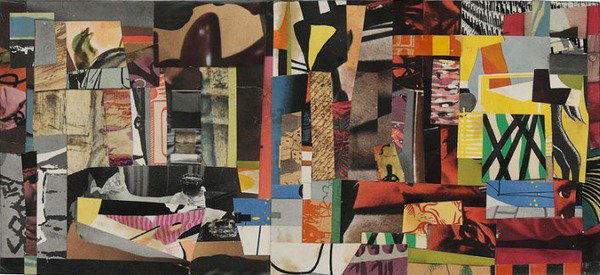Ad Reinhardt
dal 14/9/2011 al 14/10/2011
Segnalato da
14/9/2011
Ad Reinhardt
The Pace Gallery 1, New York
Works from 1935-1945. The exhibition is the first public presentation of a recently rediscovered early body of work by the artist, the majority of which had been in storage since Reinhardt's death. Nearly one hundred gouaches, drawings, collages, and works on canvas are on view. This experimental and diverse works on view shed light on artist's development of a new -and at the time radical- language of a uniquely American Abstract Expressionism.

The Pace Gallery is honored to present Ad Reinhardt: Works from 1935–1945, on view at 32 East 57th Street from September 15 through October 15, 2011. The exhibition is the first
public presentation of a recently rediscovered early body of work by the artist, the majority of which had been in
storage since Reinhardt’s death. Nearly one hundred gouaches, drawings, collages, and works on canvas are on
view. Ad Reinhardt: Works from 1935–1945 will be accompanied by a catalogue with an essay by art
historian, critic, and curator Robert C. Morgan, Ph.D.
The experimental and diverse works on view shed light on Reinhardt’s development of a new—and at the time
radical—language of a uniquely American Abstract Expressionism.
After graduating from Columbia University,
Reinhardt was admitted into the WPA’s Easel Division in 1936, where he was one of only a handful of artists
working in abstraction. Immersed in a community of lively aesthetic debate, Reinhardt would begin to define a
new lexicon, also influenced by his contact with a number of European artists, including Mondrian.
At 23, the
artist was admitted into the fledgling American Abstract Artists group and would become a loud advocate for the
avant-garde style, protesting the Museum of Modern Art and lobbying for the inclusion of abstract artists in
exhibitions. The works on view synthesize a wide range of artistic influences, from Stuart Davis—Reinhardt’s
studio neighbor—to Carl Holty and Charles Sheeler, among many others. Bold colors, biomorphic and geometric
forms, contours and linear configurations, modulated abstractions, and planar shapes come together in vibrant
paintings and collage.
“We sense the reverberation between gestural mannerism and geometrical shape,
enclosed in color, within a sequence of forceful spatial interstices that introduce a whole new terrain of abstract
terminology in American painting,” Robert Morgan writes.
In 1944, Reinhardt entered the Navy, and after going to Pensacola NAS, the Anacostia, D.C. NAS for photo-
lithography school and served as a photographer's mate on U.S.S. Salerno Bay in the Pacific. The exhibition
includes sketches the artist made as the U.S. was preparing to go to battle. Although Reinhardt did not see
combat, he was given an honorable discharge and returned to New York and his career as an exhibiting artist in
1946.
The formative work presented in Ad Reinhardt: Works from 1935–1945 sheds new light on the development of
Reinhardt’s career and the progression towards his iconic monochromes. Eventually restricting his palette to a
single color in the early 50s, working first in red, and then in blue monochromes, gradually, Reinhardt moved into
black paintings, which would become his sole focus by 1956, and which he deemed as “the most extreme,
ultimate, climactic reaction to, and negation of, the (cubist, Mondrian, Malevich, Albers, Diller) tradition of abstract
art.” 1)
The Pace Gallery has formally represented the Estate of Ad Reinhardt since 1976, and the artist’s first solo
exhibition at the gallery, organized by Arne Glimcher and the artist, prior to his death, was realized the same year.
Most recently, in 2008, Pace presented the groundbreaking exhibtion Ad Reinhardt and Tony Smith: A Dialogue,
which paired Reinhardt’s monochromatic paintings from the early ‘50s and ’60s with the reductive sculptures of
artist and architect Tony Smith (1912–1980). The highly acclaimed exhibition Mondrian/Reinhardt: Influence and
Affinity, mounted in 1997, also followed in the gallery’s tradition of pairing artistic sensibilities to reveal new
insights into artistic processes and aesthetic concerns.
Ad Reinhardt (1913–1967) has been the subject of more than sixty solo exhibitions since 1943. Works by the
artist can be found in numerous public collections worldwide, including Aac-Aichi Prefectural Museum of Art,
Nagoya, Japan; The Art Institute of Chicago; The Corcoran Gallery of Art, Washington, D.C.; Hirshhorn Museum
and Sculpture Garden, Smithsonian Institution, Washington, D.C.; Ho-Am Art Museum, Seoul; The Israel Museum,
Jerusalem; IVAM. Centre Julio González, Valencia, Spain; Kröller-Müller Museum, Otterlo, The Netherlands; The
Metropolitan Museum of Art, New York; Musée National d’Art Moderne, Centre Georges Pompidou, Paris; The
Museum of Contemporary Art, Los Angeles; The Museum of Modern Art, New York; National Gallery of Art,
Washington, D.C.; Solomon R. Guggenheim Museum, New York; Tate Gallery, London; and the Whitney Museum
of American Art, New York, among others.
1) Ad Reinhardt, “[ON THE BLACK PAINTINGS],” 1963 in Art as Art: The Selected Writings of Ad Reinhardt, ed. Barbara Rose (Berkeley:
University of California Press, 1975), 85.
Image: Untitled, 1941, paper collage, 11 x 17-1/2" (29.2 x 44.5 cm)
Press Contacts
Jennifer Joy / Sarah Goulet / Lauren Staub
jjoy / sgoulet / lstaub@thepacegallery.com 212.421.8987
The Pace Gallery
32 East 57th Street New York, NY 10022
Hours: Tues-Fri 9:30–6; Sat 10– 6



